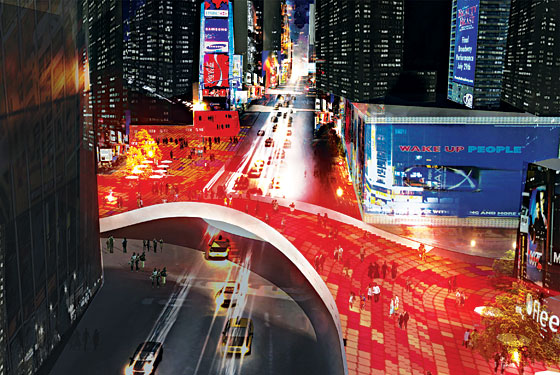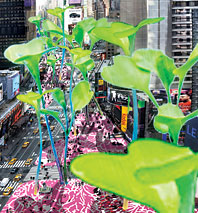
When the department of Transportation closed seven blocks of Broadway to cars this summer, New Yorkers were offered an object lesson in how profoundly urban space can be altered by a few traffic barriers and a bucket of paint. Within hours, the newly pedestrianized Times Square was colonized by wanderers, nearby office workers, and tourists calling home (“You will not believe where I am standing!”).
But what, exactly, should replace an avenue formerly filled with cars? The question seemed to catch everyone by surprise. The Times Square Alliance rushed to purchase a few hundred beach chairs from local hardware stores. By fall, the DOT had replaced them with conventional street furniture—a respectable development, if not very innovative.
To celebrate the new Broadway (and spark our imagination) we invited three design firms to suggest visionary ideas for the street’s future. None is particularly … practical. But then again, this time last year, who would have expected to see our most famous boulevard transformed into a piazza?

Designer: West 8
Significant projects: Landscape architect for Governors Island, Toronto’s waterfront.
It is crucial that Times Square not be further transformed into a theme park or playground: It must be robust, substantial, urban, and timeless, while amplifying the neighborhood’s singular reputation. To make Times Square a true public square, we propose repaving it with an LED-lighted “carpet” whose pattern suggests fireworks, spinning ticker tape, Champagne bubbles, and the New Year’s ball drop. Times Square is dedicated to the idea of verticality. How to add green in such a place? Make high, elevated places for solitary trees—“tree pedestals” that synthesize the Olmstedian lanterns of Central Park and the neighborhood street tree.
Designer: Bjarke Ingels, BIG
Significant projects: Won design competitions for a Town Hall in Tallinn, Estonia; the Danish Maritime Museum in Helsingor; and the New Tamayo Museum outside Mexico City.
The vehicular flows in Times Square currently divide the public realm into islands. We propose merging the two embankments of Seventh Avenue by lifting the pavement—like on a Venetian bridge over a canal of cars. The bridge will be paved with translucent tiles embedded with LED lights powered by harvesting the force of people’s footsteps to generate electricity. This colorful spectacle will be a monument to pedestrian power, and will turn Times Square into a giant, urban disco.

Designer: James Corner, Field Operations
Significant projects: Landscape architect for the High Line, Fresh Kills Park.
Perhaps now that pedestrians are free to roam, linger, and soak in the spectacle of New York’s most intense urban space, a new sense of “public” might be heralded over the merely commercial. Broadway could now be repaved in a bold and colorful pattern, with no more sidewalks—just a continuous promenade, generously furnished and social. Gigantic cotyledons might sprout and rise tall, creating a strangely ambient world for the miniaturized pedestrians below. At the same time, these green umbrellas would function as carbon eaters and air-quality improvers, lungs to the subways below, water collectors, and luminescent canopies at nighttime.